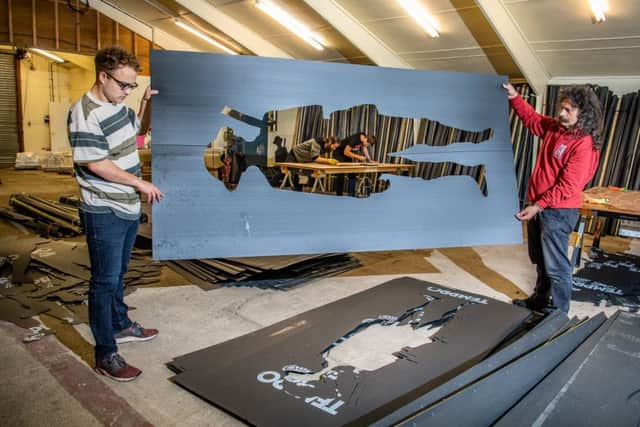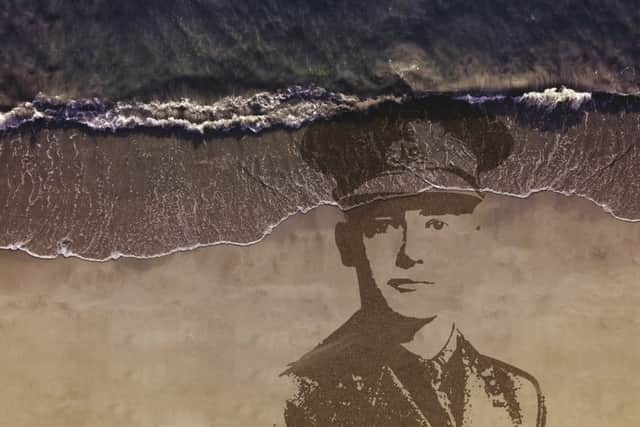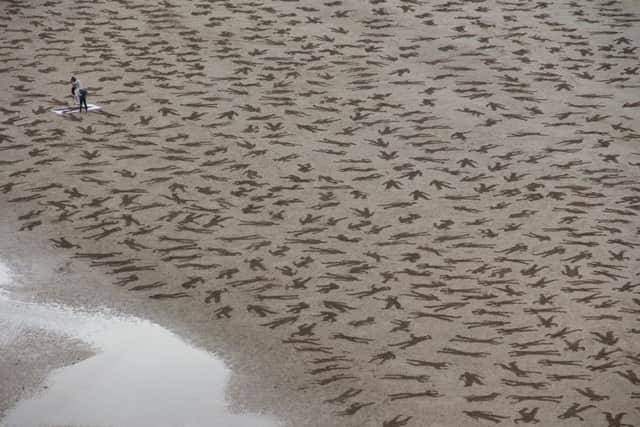Armistice 100: Yorkshire artists create sand portraits to mark centenary
Cragg Vale, a little village in the verdant Calder Valley, seems an unlikely place to find a business that specialises in creating intricate sand drawings – given the fact the nearest beach is probably at Southport, more than 50 miles away on the Lancashire coast.
But Jamie Wardley, artistic director of Sand In Your Eye studio, disagrees: “In some respects it helps because we’re in the centre of the UK and we work all over the country so it means we can get to places relatively easily.”
Advertisement
Hide AdAdvertisement
Hide AdHe and his team certainly have their work cut out this weekend as they undertake a hugely ambitious logistics operation that will see communities up and down the country gather on beaches to remember the eight million people from Britain and the Commonwealth who served in the First World War.


The project – titled Pages of the Sea – is the culmination of a five-year programme of arts commissions, part of 14-18 NOW, marking the war’s anniversary.
For this, Wardley and a team of artists have created 28 giant portraits of servicemen and women. The portraits, selected by the Imperial War Museum, measure 30 metres and will be drawn into the sand at low tide tomorrow at different locations before they are washed away.
In addition to this, members of the public are being invited to create their own portraits alongside those done by the art teams, using stencils created by Sand In Your Eye.
Advertisement
Hide AdAdvertisement
Hide AdThese will take place at more than 30 locations and the team have been busy in their West Yorkshire studio creating the stencil shapes which depict three soldiers, a munitions lady and a nurse.


“Some of the beaches aren’t suitable for such a big image but because it’s a nationwide project there’s a public engagement activity where people can make a drawing, basically a figure that you rake in the sand,” explains Jamie.
In total, they’ve created 800 stencils that have been packed off to the various coastal locations.
Sand In Your Eye has previously worked on a project at Arromanches beach in Normandy where they created 9,000 drawings of those who died there during the D-Day landings.
Advertisement
Hide AdAdvertisement
Hide AdIt was this project, which they did off their own back, that prompted the Imperial War Museum to get in touch.


The film maker Danny Boyle, who created the extraordinary opening spectacle for the London Olympics six years ago, is co-ordinating the new Armistice project which also involves a poem specially written by Carol Ann Duffy being handed out and read at the beaches.
For Jamie and his team, this is a high-profile project. “The portraits have to be sensitively done because some of the locations have a connection to a particular person,” he says.
“We’ve done big projects before but this is challenging because the portraits are big and we’re working in more than 30 different places using an extended team.”
Advertisement
Hide AdAdvertisement
Hide AdNormally Jamie is one of three full-time members of the team but for this project he’s supplemented their ranks with freelancers who have come in to help. They have had to train around 40 people who, in turn, have trained their teams. Tomorrow they will start work on the sand drawings and, as he points out, timing will be crucial. “The peculiar thing with tides is the tide in Scarborough is totally different to the one in Blackpool. So when we do a sand drawing we pick the places with the best conditions and the best viewing points.”


It’s challenging enough to do one of these portraits on a beach, but to have 28 on the same day takes something approaching military precision. “The different tides mean that some teams will have to start work at night. A lot of those on the West coast will be getting up at three in the morning and going on the beach to start drawing in the dark.
“So the challenge isn’t just doing the drawings, it’s working on a beach which can be quite a difficult environment. Most of us go to the beach on a nice day but a lot of the time it’s cold and windy and you can get isolated quite easily, so we’ve trained people how to be safe on the beach.”
The portraits are also a counterpoint to our more traditional ways of commemorating those who lost their lives in the service of their country.
Advertisement
Hide AdAdvertisement
Hide AdA century ago after the guns finally fell silent, communities up and down the country began creating war memorials to those that didn’t return home. They were built to last and to act as a sombre reminder ‘‘lest we forget’’.
What makes the sand drawings different is the fact they’re ephemeral.
“One of the reasons why it’s so appropriate is you go on the sand and spend all this time and energy creating this drawing and then it gets washed away,” says Jamie.
“People often ask if that upsets me and it doesn’t. The beach is a beautiful place and you can’t improve on that beauty but we can visit it and draw a picture. I’d be disappointed if I came back the next day and it was still there. I want it to go because I want the beach to return to what it was.”
Advertisement
Hide AdAdvertisement
Hide AdHe feels this is an apt metaphor for an Armistice project. “All of us make an impression and then we’re gone and with those servicemen and women they fought in the war, or served their country, and then their lives ended, so that washing of the tide is very poignant.
“We see these grainy old photographs from the war when people looked and dressed differently, but we’re all connected to the past and when you’re on a beach with your stencil and you’re making these figures it can really be quite moving.”
For more details visit www.pagesofthesea.org.uk